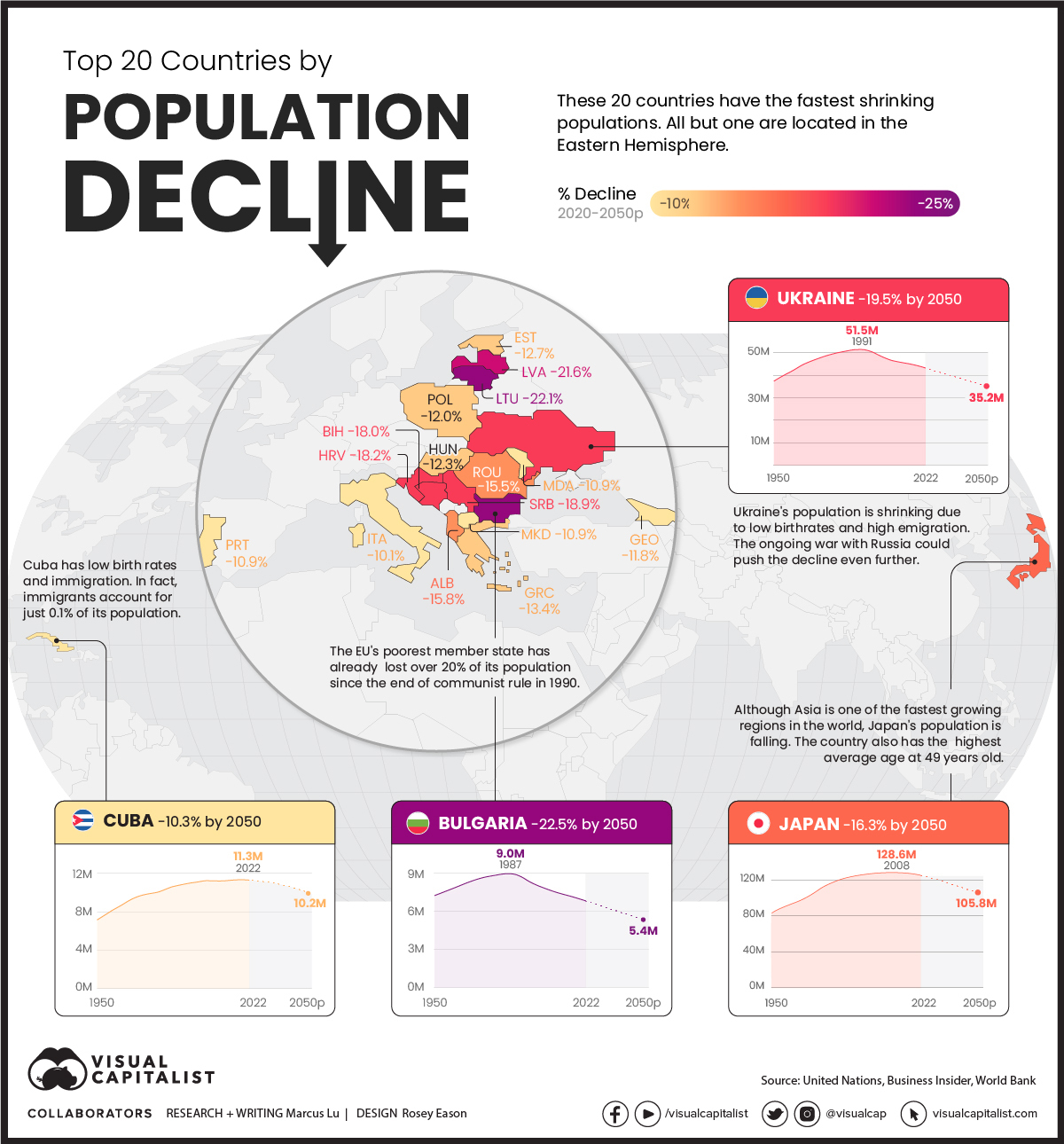
Can I share this graphic?Yes. Visualizations are free to share and post in their original form across the web—even for publishers. Please link back to this page and attribute Visual Capitalist.
When do I need a license?Licenses are required for some commercial uses, translations, or layout modifications. You can even whitelabel our visualizations. Explore your options.
Interested in this piece?Click here to license this visualization.
▼ Use This Visualizationa.bg-showmore-plg-link:hover,a.bg-showmore-plg-link:active,a.bg-showmore-plg-link:focus{color:#0071bb;}
Visualizing Population Decline by Country
Since the mid-1900s, the global population has followed a steep upwards trajectory.
While much of this growth has been concentrated in China and India, researchers expect the next wave of growth to occur in Africa. As of 2019, for example, the average woman in Niger is having over six children in her lifetime.
At the opposite end of this spectrum are a number of countries that appear to be shrinking from a population perspective. To shed some light on this somewhat surprising trend, we’ve visualized the top 20 countries by population decline.
The Top 20
The following table ranks countries by their rate of population decline, based on projected rate of change between 2020 and 2050 and using data from the United Nations.
| Rank | Country | Decline 2020-2050 |
|---|---|---|
| 1 | Bulgaria | 22.5% |
| 2 | Lithuania | 22.1% |
| 3 | Latvia | 21.6% |
| 4 | Ukraine | 19.5% |
| 5 | Serbia | 18.9% |
| 6 | Bosnia and Herzegovina | 18.2% |
| 7 | Croatia | 18.0% |
| 8 | Moldova | 16.7% |
| 9 | Japan | 16.3% |
| 10 | Albania | 15.8% |
| 11 | Romania | 15.5% |
| 12 | Greece | 13.4% |
| 13 | Estonia | 12.7% |
| 14 | Hungary | 12.3% |
| 15 | Poland | 12.0% |
| 16 | Georgia | 11.8% |
| 17 | Portugal | 10.9% |
| 18 | North Macedonia | 10.9% |
| 19 | Cuba | 10.3% |
| 20 | Italy | 10.1% |
Many of these countries are located in or near Eastern Europe, for reasons we’ll discuss below.
The first issue is birth rates, which according to the Peterson Institute for International Economics (PIIE), have fallen since the collapse of the Soviet Union. Across the region, the average number of children per woman fell from 2.1 in 1988 to 1.2 by 1998.
Birth rates have recovered slightly since then, but are not enough to offset deaths and emigration, which refers to citizens leaving their country to live elsewhere.
Eastern Europe saw several waves of emigration following the European Union’s (EU) border expansions in 2004 and 2007. The PIIE reports that by 2016, 6.3 million Eastern Europeans resided in other EU states.
The Outliers
There are two geographical outliers in this dataset which sit on either side of Europe.
Japan
The first is Japan, where birth rates have fallen continuously since 1970. It wasn’t until 2010, however, that the country’s overall population began to shrink.
By the numbers, the situation appears dire. In 2021, 811,604 babies were born in Japan, while 1.44 million people died. As a result of its low birth rates, the island nation also has the world’s highest average age at 49 years old.
The Japanese government has introduced various social programs to make having kids more appealing, but these don’t appear to be getting to the root of the problem. For deeper insight into Japan’s low birthrates, it’s worth reading this article by The Atlantic.
Cuba
The second country is Cuba, and it’s the only one not located within the Eastern Hemisphere. Cuba’s fertility rate of 1.7 children per woman is the lowest in the Latin American region. It can be compared to countries like Mexico (2.2), Paraguay (2.5), and Guatemala (3.0).
Cuba’s immigration is also incredibly low compared to its neighboring countries. According to the International Organization for Migration, immigrants account for just 0.1% of its total population.
The post Ranked: The 20 Countries With the Fastest Declining Populations appeared first on Visual Capitalist.